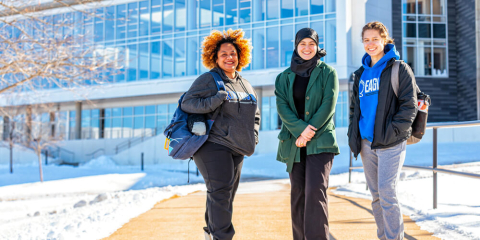Why We Study Guided Pathways
In their 2015 book, Redesigning America’s Community Colleges: A Clearer Path to Student Success, CCRC researchers Thomas Bailey, Shanna Smith Jaggars, and Davis Jenkins sought to explain why, despite over a decade of reform among community colleges across the country as part of the “completion agenda,” community colleges had not been able to substantially increase completion rates or reduce persistent equity gaps in student achievement. They argued that the “cafeteria college” model that community colleges adopted to dramatically expand access to U.S. higher education during the 1960s and 1970s inadvertently created barriers to student success. The paths to student end goals were not clear, support for career and college exploration and planning was limited, too many students failed to move beyond prerequisite remediation, students’ progress wasn't monitored, and instructional innovation was focused on improving teaching in courses rather than ensuring that students were building essential skills across their programs.
Redesigning America’s Community Colleges urged colleges to undertake wholesale restructuring of programs and student supports following the guided pathways model, which calls for systematic changes in policies, practices, and systems in four areas:
- clarifying paths to student education and career goals;
- helping students get on a path;
- keeping students on path; and
- ensuring students are learning across programs.
Since the publication of Redesigning, CCRC's thinking about the core components of guided pathways has continued to evolve, and we are building evidence on how to effectively implement guided pathways, promote equity, and measure impacts on students. Nearly 400 community colleges are implementing guided pathways reforms as part of formal national or statewide initiatives in 16 states, while many other colleges are doing so on their own.
Featured Publication
Lessons From Two Major Evaluations of Guided Pathways
This brief discusses findings and implications from two large studies of guided pathways that examined the scale at which colleges have implemented reforms and the association between adopted practices and early student outcomes.
A National Movement: Colleges Implementing Guided Pathways
How Colleges Are Doing Guided Pathways
Redesigning community colleges in the face of fiscal and enrollment uncertainty requires courageous leadership. The process requires leaders to lay the groundwork for change by engaging faculty and staff across the colleges to examine barriers to student success and engage the college in thinking and acting in very different ways.
Davis Jenkins
CCRC Senior Research Scholar
Reimagining Onboarding: The Ask-Connect-Inspire-Plan Framework
Effective college onboarding is a major component of guided pathways. The Ask-Connect-Inspire-Plan framework is a new way of onboarding students focused on helping students build momentum into a program from the start. Here are the major changes in practice.
Conventional Practice | Program Onboarding | |
|---|---|---|
ASK | Academic and career exploration assistance is mainly limited to information on websites and self-directed search. | Every student is asked about their interests, strengths, and aspirations and is guided to programs and people at the college with similar interests. |
CONNECT | Students are expected to forge relationships in their field independently. | From the start, colleges organize opportunities for all students to meet with faculty, students, alumni, and employers in fields of interest to them. |
INSPIRE | Students spend the first term/year completing developmental and general education prerequisites. | Every student takes at least one course in term 1 on topics of interest that "light their fire" for learning. |
PLAN | Some students are helped to develop first-semester schedules, followed by self-guided navigation. | Colleges help every student to develop a full-program plan used to schedule classes and monitor progress. |
Advancing Equity Through Guided Pathways
For whole-college reforms to deliver on their promise, educational equity must be front and center. In the context of guided pathways, that means colleges must do more than clarify program paths and strengthen student supports. Colleges must also dismantle longstanding barriers to success for students from underserved groups (such as traditional developmental education models), help them explore their interests and strengths, and connect them to people, courses, and experiences that can support their growth. The goal is to ensure that minoritized and underserved students are helped to enter and complete programs that lead to family-supporting jobs or transfer to four-year colleges. In these ways, guided pathways has the potential to promote intergenerational social mobility among community college students.
For more on adopting an equity mindset in guided pathways reforms, see "Guided Pathways Reforms Designed With Equity in Mind."
Featured Tool
Guided Pathways Workshops
CCRC's guided pathways workshop series includes resources to help you reimagine program onboarding at your college using the Ask-Connect-Inspire-Plan (ACIP) framework. The self-guided workshops focus on helping students choose a program of study; connect with faculty, students, and others with similar interests; take a course that “lights their fire” for learning; and build a full-program educational plan.
CCRC's Guided Pathways Research Agenda
CCRC is studying the choices colleges are making as they implement guided pathways, how they are managing the reforms, and the impacts they are having on students. Some of the questions we’re addressing include:
- What practices are colleges implementing and at what scale?
- What are the costs of guided pathways reforms and how are colleges paying for them?
- Are guided pathways reforms sustainable for community colleges?
Further Reading
Related Blog Posts
Our Guided Pathways Experts
Davis Jenkins
Senior Research Scholar
Hana Lahr
Senior Research Associate and Director of Applied Learning
Maggie Fay
Senior Research Associate
John Fink
Senior Research Associate and Program Lead













